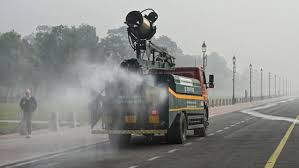
Delhi Suffocates Under Persistent Smog: Air Quality Remains ‘Severe’ for 5th Consecutive Day
Delhi continues to grapple with hazardous air quality as a thick blanket of smog envelops the city for the fifth consecutive day. The air quality index (AQI) remains in the ‘severe’ category, posing serious health risks to residents and raising urgent concerns about pollution control measures.
Current Air Quality Status
According to data from the Central Pollution Control Board (CPCB), the AQI levels in various parts of the city have surpassed 450, which falls into the ‘severe’ category. Areas like Anand Vihar, Rohini, and Dwarka recorded some of the highest pollution levels, with visibility also severely reduced due to the dense smog.
Causes of the Persistent Smog
The alarming rise in pollution levels is attributed to several factors, including:
- Stubble Burning: Large-scale crop residue burning in neighboring states such as Punjab and Haryana continues to contribute significantly to the city’s pollution.
- Vehicular Emissions: Increasing traffic on Delhi’s roads adds to the already high levels of particulate matter in the air.
- Industrial Emissions: Factories operating in and around the National Capital Region (NCR) release harmful pollutants into the atmosphere.
- Weather Conditions: Calm winds and cooler temperatures have trapped pollutants close to the ground, exacerbating the smog situation.
Health Impacts
The prolonged exposure to such hazardous air quality poses severe health risks, including:
- Respiratory problems like asthma, bronchitis, and lung infections.
- Irritation in the eyes, nose, and throat.
- Long-term exposure may lead to cardiovascular diseases and reduced lung function.
Health experts have advised residents to limit outdoor activities, wear N95 masks when stepping out, and use air purifiers indoors to mitigate the risks.
Government’s Response
The Delhi government has implemented several measures to combat the pollution crisis, such as:
- Graded Response Action Plan (GRAP): Restrictions on construction activities, road dust management, and limitations on industrial operations.
- Odd-Even Scheme: Restrictions on vehicle movement based on license plate numbers may be reintroduced if the situation worsens.
- Anti-Stubble Burning Campaigns: Efforts to collaborate with neighboring states to curb stubble burning are ongoing.
Despite these measures, environmental activists argue that stricter enforcement and long-term strategies are needed to tackle the recurring air pollution crisis effectively.
What Can You Do?
While large-scale changes require government intervention, individuals can take small steps to reduce their carbon footprint and stay safe:
- Carpool or Use Public Transport: Reduce the number of vehicles on the road.
- Avoid Burning Waste: Opt for proper disposal methods to minimize emissions.
- Plant Trees: Increase greenery around your home to improve air quality locally.
Conclusion
Delhi’s air pollution crisis is a stark reminder of the urgent need for collective action. From stricter policies to individual efforts, addressing this persistent issue requires a united front. As residents battle the smog, the focus must shift towards sustainable solutions to ensure cleaner air for future generations.
Stay informed, stay safe, and advocate for a greener, healthier Delhi.
